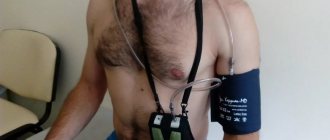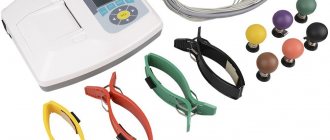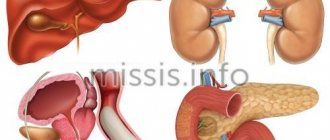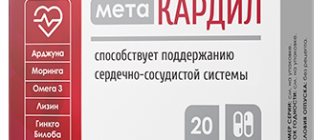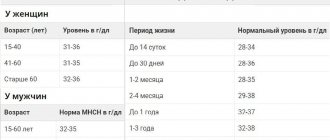Download Slideshow
PDF file
The patient's diary is filled out independently. Filling out the diary is a mandatory condition for conducting the survey. If the diary does not record the stress, medication and your sensations, the doctor will not be able to assess their effect on the heart and the study may be useless.
During monitoring, you should not wear synthetic or woolen underwear (cotton only). You can place the monitor next to you while you sleep.
Instructions for preparing for Holter monitoring
The diary should note:
What is Holter
This is a method of continuously recording an ECG during normal daily activity, recording the results on a memory card and further analyzing the data obtained.
The main idea of ambulatory electrocardiography is to increase the duration and possibility of recording an ECG in the patient’s natural environment, which implies an increase in the diagnostic significance and sensitivity of the method to cardiac rhythm and conduction disturbances.
A Holter monitor is a portable cardiograph the size of a mobile phone, which is connected via wires to sensors attached to the surface of the body. This device continuously takes an electrocardiogram over a 24-48 hour interval.
In contrast to short-term ECG recording with a standard cardiograph, long-term Holter cardiac monitoring helps:
- Assess the relationship between the occurrence of arrhythmias and clinical symptoms, including syncope.
- Identify transient cardiac arrhythmias in patients with appropriate clinical symptoms.
- Register the moments of the onset and cessation of paroxysms, which makes it possible to identify the mechanism of arrhythmias and carry out differential diagnostics.
- Make a quantitative and qualitative assessment of arrhythmias necessary for risk stratification (assigning a patient to one group or another, taking into account the likelihood of complications).
- To establish the dependence of the occurrence of arrhythmias on the deficiency of coronary blood flow.
- To check the effectiveness and safety of drug therapy for arrhythmias.
- Assess the functioning of implanted devices (pacemakers, cardioverter-defibrillators).
What to write in your diary
It is necessary to record all types of activities in as much detail as possible. If the duration of the study is more than 24 hours, the quality of sleep must be described in the diary (for example, restful deep sleep, difficulty waking up in the morning, insomnia). Moderate drinking and smoking are not prohibited during the study (if this is an integral part of the patient’s daily life). In this case, you need to indicate in your diary the number of cigarettes and alcohol consumed. On an individual basis, the doctor may ask you to record the time you drink coffee and its amount, since this drink affects your heart rate. It is necessary to scrupulously record all sensations and symptoms. For example, an attack of shortness of breath, a headache, a feeling of increased heart rate. These data play an important role in making a diagnosis.
Mechanism of operation
The result of the latest developments has been the appearance on the market of devices with multifunctional monitoring, which, in addition to the ECG, record blood pressure levels and other physiological parameters.
The mechanism of operation of 24-hour cardiac monitors is identical to an ECG device. Sensors are fixed on the patient’s body, with the help of which continuous (or episodic in case of multi-day fragmented monitoring of events) recording of the electrical activity of the myocardium occurs. Through the wires, the indicators are transmitted to the recorder with a memory card. The latest models provide online data transfer function.
What should be the daily routine?
The most common one. Medicines should be taken in accordance with the prescription of the attending physician. When you sleep, it is best to do this on your back or right side. Be sure to include in your diary the time you fell asleep and woke up, and describe the quality of your sleep.
What not to do
- wash and bathe (you can only wash your face and brush your teeth);
- Ultrasound;
- physiotherapy,
- massage;
- FGS;
- undergo a tomograph;
- undergo X-ray examinations;
- ride a bike;
- clean the floor;
- do push-ups or exercise;
- lift weights.
What to limit:
- working on a computer;
- talking on a cell phone;
- rides in the elevator;
- riding a tram and trolleybus;
- any load on the shoulder girdle.
Loading your legs is not contraindicated. You can take a walk or go to the store in complete peace.
Be careful not to hit the recorder!
How does the device work and what types are there?
The Holter heart monitoring device provides:
- long-term ECG recording under conditions of the patient’s daily standard activity;
- playback of recorded signals;
- decoding and interpretation of the received data.
Most modern 24-hour ECG monitoring systems consist of:
- Recording device:
- Electrodes (sensors attached to the surface of the body).
- Connecting wires.
- Main cable.
- Pressure alarm.
- Registrar.
- Analyzing part. Software that performs system analysis of recorded data.
The recorder is fixed to the body of the subject for the entire monitoring period. The device is powered by a battery or batteries. Indicators are usually recorded on a removable storage medium (flash card).
On the body of most recorders there is an “event marker” button, which the patient presses when certain symptoms appear.
For convenience and preservation of research results, the reading part of the device transfers and converts the information contained on removable media to the analyzing element (a computer with special programs for decoding and characterizing the ECG signal).
Continuous contact of the recorder with the patient's body is ensured using disposable self-adhesive electrodes consisting of silver and chlorine alloys.
Comparative characteristics of devices for ambulatory cardiogram monitoring:
| Technology | Registration duration | Advantages of the method | Flaws |
| Holter ECG monitoring | 24-48 hours |
|
|
| Fragmented event monitoring | 1-30 days |
|
|
| External loop monitoring | 1-30 days |
|
|
| Implanted loop monitoring | Unspecified amount of time |
|
|
| Pacemaker monitoring | Unspecified amount of time |
|
|
| Hospital telemetry | 1-7 days |
|
|
| Out-of-hospital telemetry | 1-30 days |
|
|
There are also cardiorespiratory systems, in which, in addition to the ECG, sensors for monitoring respiration, oxygen in the blood, and patient movements are installed. Such a study is often carried out during sleep, and the results are deciphered by a somnologist.
Main manufacturers and their features
The leaders in the production of cardiac monitors are the UK, Germany and the Czech Republic. There are also several companies in Russia offering Holter monitors at a lower cost.
The price of the device depends on the set of additional functions, ease of use, battery and memory card capacity, as well as the duration of continuous operation, the possibility of online transmission of indicators and software for data decryption.
As is known, in some patients, episodes of arrhythmia occur rarely and it is impossible to register them during Holter. For this purpose, cardiac technology for fragmented ECG monitoring was developed. So-called “event recorders” record a short ECG episode after the device is activated by a patient who is experiencing symptoms at that time. At the end of the recording, the data is saved in memory and sent to the doctor via phone.
Comparison of the latest 24-hour ECG monitoring devices:
| Manufacturer of cardiac monitors | A country | Weight | Advantages |
| HolterLive | Germany | 38 grams |
|
| ECG Myocard-Holter | Russia, Saratov | 50-85 grams |
|
| Heaco | Great Britain | 42 grams |
|
| BTL CardioPoint | UK/Czech Republic | 106 grams |
|
| Schiller MICROVIT | Switzerland | 110 grams |
|
| Inkart | Russia | 110 grams |
|
Hypertension and other types of hypertension: causes and treatment
Arterial hypertension is often called “the scourge of the civilized world”: it is registered in a third of the population of developed countries, with men under 50 more often affected, and women after 50. It can develop both as an independent disease and as a complication of other health disorders: diseases of the kidneys, heart and blood vessels, endocrine system or lungs.
People suffering from high blood pressure often call their illness arterial hypertension, but from a medical point of view this is incorrect. Blood pressure (BP) does increase due to excessive vasoconstriction, but sometimes their tone remains normal or even decreased, and the mechanism of disease development is completely different.
Unfortunately, hypertensive patients do not always know about their disease, attributing periodic ailments to the weather, drinking a cup of coffee at the wrong time, or fatigue. Even very high blood pressure does not always make itself felt until “the time bomb explodes” - and this could be a stroke, visual impairment, even blindness; heart attack; heart and kidney failure.
The consequences of hypertensive crises cause the death of more than half of older people with high blood pressure. Therefore, even healthy men and women after 40-50 years of age should understand what arterial hypertension is, check their blood pressure from time to time and know what to do if they notice dangerous symptoms. People who have:
- are overweight and have bad habits (smoking, alcohol abuse);
- A lack of potassium in the diet was identified. A strict diet and some diuretic medications can lead to it; it threatens athletes and those engaged in heavy physical labor (they lose potassium through sweat);
- bad heredity. However, if your mother, father or other relatives suffered from hypertension, this does not mean that you will necessarily develop arterial hypertension, but you will have to be doubly attentive to your health;
- A cholesterol metabolism disorder has been diagnosed (for example, in diseases of the liver and gallbladder).
Hypertension sooner or later overtakes lovers of “salty, spicy and smoked” foods. Eating canned foods, sausages and other prepared foods leads to the fact that even without adding salt to the food on our plate, we eat three times more table salt than the body needs.
Conditions associated with a persistent increase in blood pressure are usually divided into two groups: primary (hypertension) and symptomatic arterial hypertension. They have similar symptoms, but are treated differently.
Indications for daily ECG monitoring
Continuous ECG monitoring throughout the day helps to identify the pattern of arrhythmias, their specificity, and additional phenomena that develop when normal heart rate resumes. This allows you to decide on treatment tactics.
Daily Holter ECG monitoring is indicated for:
- Complaints indicating arrhythmias (palpitations, irregular heartbeats, freezing, loss of consciousness, dizziness, chest pain).
- Stratification of the risk of life-threatening arrhythmias in patients without characteristic signs of pathology, but with:
- Hypertrophic cardiomyopathy.
- Recent acute coronary syndrome complicated by circulatory failure or arrhythmia.
- Long QT syndrome.
- Verification of the diagnosis of arrhythmia in patients with a latent course of the disease.
- The need to check the effectiveness of selected antiarrhythmic drugs.
- Assessing the functional state of an implanted cardiac device:
- In patients with complaints of heart failure.
- With individual device settings.
- Assessing insufficiency of blood supply to the myocardium in cases of suspected:
- Prinzmetal's angina.
- Acute coronary syndrome.
- Ineffectiveness of drug therapy for ischemic heart disease.
- To characterize heart rate lability in patients with diabetes mellitus and sleep apnea who have suffered acute coronary syndrome, which is complicated by heart failure, as well as to determine disorders of autonomic innervation.
- Monitoring 24-hour dynamics of the QT interval if long QT syndrome is suspected.
The most common indication for Holter is symptoms indicating arrhythmia:
- recurrent rapid heartbeat;
- dizziness;
- fainting states of unknown origin;
- periodic chest discomfort, shortness of breath, weakness.
24-hour Holter heart monitoring has no absolute contraindications.
Additional recommendations for blood pressure monitoring
- Daily blood pressure monitoring is carried out in order to more accurately determine blood pressure levels and the degree of its reduction during treatment.
- The device measures your blood pressure by inflating a cuff placed on your upper arm and then gradually deflating it, just as a doctor measures your blood pressure. Measurements occur automatically at a certain time interval (most often during the day after 15 - 20 minutes, at night after 30 - 40 minutes). Before starting the next measurement, the monitor gives a warning sound. When you hear it or feel that the cuff on your arm has begun to inflate, stop and do not move while the device is inflating and, especially when releasing air, keep your straightened arm with the cuff relaxed and motionless until the very end of the measurement. Do not move or bend your arm during measurement. Otherwise, this measurement may fail and the device may repeat it after 1 minute.
- If you experience any unpleasant sensations that may be associated with changes in blood pressure, you can start an extraordinary measurement by pressing the “Start” button on the monitor.
- If you see that the cuff has slipped off your shoulder or is twisted, contact medical staff or, if this is not possible, correct it yourself between measurements. Note this in your diary.
- Be sure to record the quality of your night's sleep in your diary - did the monitor interfere with your sleep?
Rules for performing the examination
Before starting the study, the patient becomes familiar with the following information:
- date and time of the next visit to remove the device;
- rules for keeping entries in a diary;
- cases of using a push-button analyzer;
- prohibition of bathing and the use of electrically heated bed linen;
- prohibition on self-configuration of the registrar;
- constant monitoring of the position and contact of sensors, wires and timely restoration of normal operation of the device.
If there is excessive hair growth on the skin of the subject where the sensors are planned to be applied, it must be removed. Then the skin is treated with isopropanol or acetone and wiped with a special sponge or abrasive paste to completely degrease. This reduces skin resistance, which improves recording quality and prevents electrode lag during physical activity. After gluing the sensors, check their resistance (no more than 8 kOhm).
The electrodes are connected to the recording device using wires 85-95 cm long. Then they are fixed on the patient’s skin with a plaster, twisting it into a loop (better shock absorption during movements). During the hot season, the sensors are secured with double the amount of plaster. While sleeping, the subject wears tight underwear.
Sensors are usually placed on areas of the body with a small volume of muscles to avoid artifacts and signal distortion during active movements.
After installing the device, a functional test is performed to determine the reliability of contact of the sensors with the skin. To do this, an ECG recording is displayed on a computer monitor while the patient changes the position of the body in space.
Then a power source is inserted into the recording device, which is placed in a case and attached to the belt.
Climbing stairs
During ECG and blood pressure monitoring, it is recommended to perform three physical activities in the form of climbing stairs, of course, if you do not have a restriction on the motor mode, which is established by the attending doctor. Climbing the stairs must be done three times, distributing them throughout the day, for example: in the afternoon, in the evening and in the morning immediately after climbing. You should climb at a normal pace, without stopping, until any unpleasant sensations appear in the heart area (shortness of breath, palpitations, pain, interruptions, etc.) or physical fatigue. Stop as you always do - don't try to do more work than usual! It is important for us to assess exactly your daily exercise tolerance. If there are no unpleasant sensations, the ascent continues to the end of the stairs and ends there. The load should be performed according to the following method:
- Before going up, on the first floor, you should stand and rest for 3 minutes to restore your heart rate (pulse);
- Press the button on the ECG monitor or the “sensation” button on the blood pressure monitor, and then continue climbing at your usual pace ;
- At the end of climbing the stairs, press the same button again. In the diary it is necessary to note: the number of steps climbed, the start time of the climb and its duration, as well as the unpleasant sensations that forced you to stop the load.
Keeping a patient diary
During the period of daily Holter ECG monitoring, the patient is required to keep a diary, where the necessary fields must be filled out in detail.
This document consists of two halves:
- Part A, where the patient indicates:
- Type of activity (sleep, walk, physical work, driving, stress).
- Signs of pathology (pain, heartbeat, shortness of breath, chest tightness, dizziness, sudden weakness).
- Time of medication use (name and dose).
- Hours of start and end of activity and complaints (from – to).
Example:
| Time | Occupation | Signs of the disease |
| 10:00-12:00 | Walk in the park | Chest pain |
- Part B (the patient fills out only for chest pain):
- Character (dull, pressing, stabbing).
- Time of occurrence (rest, work, stress, sleep).
- The intensity of pain decreases on its own (when), after stopping the load, taking nitrates.
Additionally, on the model of the torso, the patient indicates the localization of pain.
Holter monitoring diary sample
Holter monitoring is an important diagnostic procedure that evaluates the functional functioning of the heart and the entire cardiovascular system during normal human activity. The examination can be completed within 1-3 days, so it is very important to carefully follow all the doctor’s recommendations. The key to the success of a correct diagnosis after the procedure is a detailed diary of a person’s activities. How to fill out a Holter monitoring diary? Let's look at examples and basic rules.
